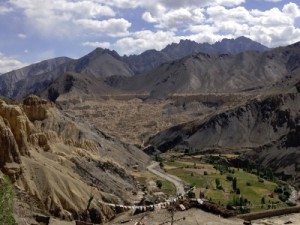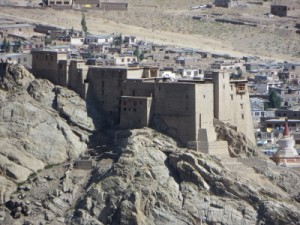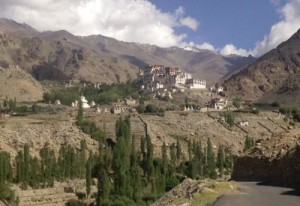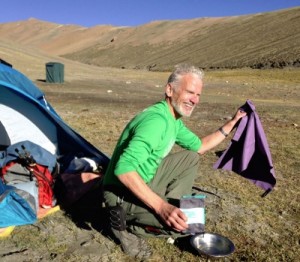
Ladakh, India Trek
In September, we flew to the remote northernmost region of India, Jammu and Kashmir (known as “J&K”) that borders Pakistan and China, to explore the Ladakh area. This region is on a high-altitude plateau situated between several mountain ranges, including the world’s two highest the Karakoram and the Great Himalayas.
We arrived to Leh, capitol city of the Ladakh region, to start our 15 day tour. We saw the sites in Leh, went on treks throughout the Ladakh area, and even rafted the Zanskar River.
To learn about our adventures, we are sharing our itinerary and photos below. Good to note: we will share photos on our Instagram and Pinterest accounts (find the social media links on the homepage www.GlobalAdventuress.com).
The Lakes of Rupshu – 15 day tour/ 8 days Trekking
Rumtse – Tisaling – Nuruchan – Korzok
The remote high plateau of Changthang (meaning ‘northland’) stretches from western Tibet into eastern Ladakh. This region, known as the land of the nomads gave us an experience of a lifetime. We met Tibetan nomads near their black yak-hair tents, and learned about their lifestyle. We passed through stark mountain desert landscapes, before descending to the oval-shaped banks of Tsomoriri. The lake changes its color with the light, from turquoise blue to deep cobalt. The area we passed through is an important wildlife sanctuary, harboring snow leopards and wild horses (kyang), as well as many species of birds.
This trek is one of the highest in Ladakh. One doesn’t get to sleep lower than 14,400 ft. and the passes are up to 3,280 ft. higher. Excellent physical condition is required, as well as a good acclimatization before starting out.
Apart from discovering the high altitude plateaus on the Ladakh India trek, we saw parts of the Indus Valley (Ladakh proper), with its magnificent gompas (monasteries) and awesomely bright-green oases set amidst bare and forbidding, but very colorful mountains. If there is one thing that impresses here, it is the way people have been able to eke out a living in an utterly hostile climate with the help of an ingenious irrigation system, a hardy strain of barley and an incredible amount of optimism.
Trek Itinerary
Day 1 Arrive Delhi; continue by flight to Leh (Ladakh)
Early morning, our international flights arrived into Delhi, and we transferred to the domestic terminal to fly direct to Leh in Ladakh. Though the flight takes only one hour, on a clear day it is no doubt one of the most spectacular flights in Asia.
After leaving the North-Indian plains we crossed a number of ranges, including the glacier-clad Pir Panjal Range, before flying over the actual Himalayan Range, the highest mountain range in the world. We were amazed at the different landscape we saw beneath us on the other side: bare, lightly colored mountains without any vegetation and tiny rivers that are only recognizable from the string of green poplars and willows accompanying them.
Likewise, the tiny hamlets of Ladakhi farms are surrounded by deep-green fields of barley, made possible by ingenious forms of irrigation, which are harvested in September.
Leh airport is situated at 3500 m altitude. We felt the altitude, and it was wise to take the rest of the day off and rest at the hotel, and take small walks around the Leh bazar. We found a shop where traditional Ladakhi hats were sold and tried some on.
Our guide told us that, “Only if you wake up next morning without a headache you may consider yourself fit to go for not too strenuous excursions.”
Ladakh is known for its Buddhist ‘Tibetan’ culture. In Leh we stayed at a pleasant hotel built in traditional Ladakhi/Tibetan style called Lha-ri-Sa Resort.
Day 2 Leh, city tour
Leh is a bustling little town, with a very prominent and historically important position. Before the closing of the border between India and China-held Tibet, Leh saw daily caravans going to and coming from Yarkand and Kashgar in Turkmenistan, Kashmir, Kullu, Baltistan and Lhasa. It was a hub where seven different important caravan routes converged. Yaks, donkeys and camels were parked outside the city waiting for new cargo and in the main bazaar, a multitude of languages such as Turkmeni, Balti, Tibetan, Kashmiri and Chinese could be heard.
These days, the caravans have been largely replaced with modern SUVs that stay within Ladakh ferrying tourists to its remote corner. But horses and donkeys, as well as their owners, have found new employment in transporting the foreigners’ luggage while the guests tread in the footsteps of the erstwhile caravaneers and explorers.
While in Leh, there are numerous things to do. Apart from short walks in and around town, you can browse the little streets and allow yourself to be lured into some of the many little shops, most of them run by Kashmiris and Tibetans that sell beautiful Tibetan artefacts, carpets and jewelry. Leh abounds in restaurants that cater to all tastes, quite a number of them located on a rooftop or in a pleasant garden.
If you are interested in the work of the many NGO’s that try to ‘make things better’, the Ladakh Ecological Development Group (LEDeG) and the Women’s Alliance of Ladakh are highly recommended. Both have won international acclaim for the promotion of sustainable development. In the afternoon, we took a half-day tour of Leh, and visited the Shanti Stupa (Peace Stupa), with excellent views of Leh and the Indus Valley, the tiny but old and very atmospheric gompa of Sankar, the old Leh palace and nearby Tsemo Gompa, and Leh bazaar.

We spent the first two nights/days resting with some walks through town for acclimatization, since the upcoming treks would require us to ascend to much higher elevations.
Day 3 Leh – Lamayuru – Ule Tokpo; visit monasteries of Lower-Ladakh
On Day 3, we ventured out to explore the Indus Valley downstream, and continued to Lamayuru monastery. There are several other monasteries between Leh and Lamayuru, such as Likir and Ridzong Gompa.
Lamayuru Gompa is one of the monasteries in Ladakh. It is spectacularly situated, overlooking a wide valley with remarkable creamy yellow-colored silt deposits called “Moonland” that indicate the existence of a huge lake once upon a time.
The gompa belongs to the Kargyugpa (‘Red hat’) sect, a subdivision of the Nyingmapa, or old sect, and houses about 50 monks though many more are associated with gompa, working or studying elsewhere.
We returned and drove along the Indus to the tiny hamlet of Ule Tokpo, where we spent the night at a pleasant ‘ethnic resort’ overlooking the raging river Indus.
Day 4 Ule Tokpo – Leh
On Day 4, we returned to Leh and stopped to visit the Alchi Gompa. This is the oldest, more or less intact monastery in Ladakh. It is approximately 1,000 years old and has miraculously survived the assaults of rains, earthquakes and passing muslim armies.
It is said to have been constructed between 996 and 999 A.D. by Rinchen Zangpo, known as the Great Translator. The monastery is well known for its iconography in the remarkable mandalas, stuccos and marvellous paintings. It was established about 1,000 years ago and was part of the Western Tibet School that originally had designed a different art form (mandalas, paintings, icons and statues).
If you are used to seeing the present day ‘Tibetan’ monastic art, you’ll be struck by the different looks of the statues and paintings at Alchi. To the un-discerning eye, they seem more reminiscent of Hindu art. The reason lies in their age. The art you see here, was made by Kashmiri artists (Kashmir was Buddhist then) before the time when the ‘modern’ Buddhist art form was introduced. The latter happened about 800 years ago with the arrival of Guru Padmasambhava (in Zanskar, Ladakh Spiti and later Bhutan and Tibet).
With the instructions of his new sect, both in terms of philosophy and art, the old philosophy of Western Tibet School was lost and their unique philosophical practices almost died. After visiting the Alchi Monastery, we stopped to view the temple of Basgo. During the 900 years of Ladakhi independence Ladakh was divided in lower and upper-Ladakh.
Lower Ladakh was ruled from the castle at Basgo. The castle is half in ruins but still worth a visit for its atmosphere. The ‘royal’ temple here is relatively well conserved, though.
Day 5 Drive Leh- Rumtse (3 hrs); walk Rumtse – Kyamar (3 hrs)
The drive from Leh to Rumtse, where the longer trek started, had incredible views of the Indus Valley and many monasteries along the way. At Rumtse the packhorses were waiting. While the guides packed up the horses, we had our lunch by a stream.
The first day of this trek included a short walk on a rather flat terrain to help us acclimatize, and camping overnight at Kyamar (4,050m). 
We decided to camp before the first pass (Kyamar La), then press on over the next one (Mandalchan La) till Tisaling at 5,030 m the next day.
Day 6 Kyamar – Tisaling (6-7hrs)
Feeling fully energized with a wash up and proper breakfast for a challenging day ahead, we started with a gradual ascent towards our first pass of Kumur La (5,130 m). From this pass, we had a spectacular view of the Changthang range with its colorful mountains. After the pass, we steadily descended towards the base of the next pass.
Here we saw nomads with their herds of sheep, goats and yaks. After a short rest and lunch break, we set out for Mandalchan La (5,230 m). From this pass it’s an easy descend to the camping site at the high pastureland of Tisaling (5,030m).
Day 7 Tisaling – Pongunagu (6 hrs.)
At this point, we felt well acclimatized to conquer the third pass, the Shinbuk La (5,300 m). It took about 3 hours to walk to the top of the pass, where we had incredible views of the surrounding mountains and next destination, Tsokar Lake.
Heading down to the lake, we heard shrill whistles of the shy and active marmots, which are characteristic of this harsh region. With some luck, you can see the tiny Himalaya weasel here, as well as the majestic lammergeier (a vulture). On our way, we passed mani stone walls with prayer rocks.
It took about 4 hrs walking to the Tsokar basin, and our camp for the night was at the windy Pongunagu plain (4,575m).
Day 8 Pongunagu – Nuruchan (4 hrs.)
For most of the day, we followed a small road towards Tsokar Lake. Along the salty shores of the lake, we had the rare opportunity to see some of the endangered migratory birds of the world. From here we carried on along the trail to the right of the lake, traversing barren land until we reached the small settlement (semi-nomadic) of Nuruchan (4,630m), where we were welcomed by grassy land with streams nearby.
Day 9 Nuruchan – Rajungkaru (3-4 hrs)
Today we first crossed the icy cold stream in Nuruchan before we started the gradual climb to Rajungkaru, passing the Horlam Kongka La (4,900 m), which apprears to be a mere hill in this all-around high and majestic landscape.
At Rajungkaru we saw the Changpa (Tibetan nomads) living here their yak-hair tents (in summers they also use white cotton tents) with their big herds of Yak and goats.
These nomads are of Western Tibetan origin. When the Chinese overran Tibet, these nomads and their animals faced numerous hardships, fighting biting cold and losing personal and animal lives while fleeing into Ladakh. Today they continue to live their hard but peaceful life within the (relative) safety of the Indian borders. The tiny goats that the changpa herd carry a small capital on their backs. The wool is called pashmina, a term that can only be used if the sheep live year-round above 4000 m. It is sold for good money to Kashmiri buyers, who weave into fine scarfs etc., known as cashmere.
The Changpa also have sturdy dogs, whose daily job it is to keep wolves and snow leopards at a distance, and these are not in favor of visits to their owner’s tent without prior reservation. So you need to shout first when you approach a nomad tent.
Day 10 Rajung Karu – Gyamar Lhoma (7-8 hrs.)
Following the stream for a short while, we encountered another nomad settlement. Then ascended the Kyamayuri La Pass (5,425 m), a bit challenging in nature, but the magnificent view from the top made it well worth the strenuous efforts.
After the pass, the trail led towards the northeast into a long and wide valley. Reaching the end of it, we veered off onto the right hand slope, and after a brief climb, reached another small pass called Kotske La (5,400 m). Here we had good views to the east. After crossing a small river we reached a wide valley again, with a campsite just after crossing another side river. Here, at Gyama Lhoma we camped for the night. At 5,160 m, this is a cold place and serious frost can happen any time of the year. 
Day 11 Gyamar – Korzok (6-7 hrs.)
Another climbing day brought us atop the highest and final pass on the trek. Following the narrow valley until the Yalung Nyaulung La (5,450 m), we saw some rare flowers and herbs of the Himalayan region.
To our right we viewed snowcapped mountains and from the top of the pass we finally had a view of the lake Tsomoriri, surrounded by snowcapped mountains.
We descended steeply for a couple of hours to Korzok Phu, the summer pasture of the Korzok people. From the pasture, we continued to the Korzok (Tsomoriri lake), the destination of our adventure.
Day 12 Drive Korzok – Leh (6-7 hrs. of driving)
Today, we drove back to Leh along the gorge of the mighty Indus and were awe-struck by the fascinating shapes and colors of the mountains on both sides of the river.
Day 13 At Leh
This day was a free day to explore the Leh bazar, buy souvenirs or go out on jeep excursions into the Indus Valley. Our fabulous tour company provided multiple options from Tibetan weaving to solar energy techniques. Some of our adventurous group decided to raft the Zanskar.
Day 14 Flight Leh – Delhi
On this early morning flight we had a second chance to take some spectacular pictures of the Indian Himalayas. On a clear day, you can see the K2 in Pakistan.
Ladakh India Trek Sponsors
Global Adventuress would like to thank the following companies for the items they donated to this trekking team.
If you’re looking for items to bring on your next trek, we recommend the following products:
ExOfficio – Many of us wore ExOfficio adventure clothing on our travels through India, and trekking up to 14,000 ft. The clothing is comfortable, quick-drying, lightweight, wrinkle-free, with bug, sun, and water protection. Especially love their best-selling Give-N-Go® underwear! ExOfficio believes that the magic of travel, whether you seek different cultures, epic scenery, or the thrill of the unknown, is a chance to create perspective and vitality by opening your mind to the wonders of the world.
Goal Zero – Trekking in the remote far north mountain ranges of India, means no electricity. We were 100% dependent on the sun, and the only way we could power up our devices – phones, cameras, and tablets, was with the Goal Zero solar panels. Our favorite solar panels and kits were the Venture 30 Solar Kit, and the Sherpa Solar Recharging Kit. The Goal Zero equipment was easy to set up, power up, and charge devices. Robert Workman is the Founder of Goal Zero, and believes it’s possible to “put reliable power into every human hand on this earth, without overwhelming our resources.” He’s right and without Goal Zero we wouldn’t have had sufficient power on our 8-day trek.
Gregory Pack – The Gregory Packs are customized to carry Goal Zero solar panels while trekking and backpacking. Our favorites? For men the Stout 45, and for women, the Amber 44, a 44-liter pack ideal for hiking in the woods, long weekends in the desert, and week-long surf trips. A bottom-panel access zipper makes pitching your bivy and packing up a breeze, while features like adjustable fit, internal hydration management make a difference. Easy to attach Goal Zero solar panels and start your hike, while catching sun rays along the way!
SteriPEN – One of our most valuable items was the Steripen Classic 3 that made it possible for us to filter water throughout our trek. The original handheld UV water purifier is now even better! Trusted on mountains and trails for over 15 years, SteriPEN® Classic is the best-selling portable UV purifier of all time. Since 1999, hundreds of thousands of people have ensured their drinking water is safe and avoided ruined adventures with SteriPEN® Classic. The next generation of Classic operates on four AA batteries batteries. With one set of alkaline batteries, Classic 3 purifies up to 50 liters or supercharge your Classic 3 with lithium batteries and treat up to 150 liters. With a lamp life of up to 8,000 liters, you’ll be drinking safe water for over 7 years!
Nuun – Our trekking team had enough Nuun tablets to last us through our trek. Just when your energy hits a low, we added a Nuun tablet to our water bottle, and it gave us that extra boost to help us get to the next high mountain pass. nuun is leading the way in portable hydration with electrolyte enhanced drink tabs designed to keep you hydrated no matter where your lifestyle takes you.
Pacsafe – Loved our Pacsafe handbag that kept our documents and gear safe. Pacsafe provides smart travel gear, and are the global traveler’s best travel buddy, dedicated to creating innovative ways to help keep your gear secure
Cascade Designs – Cascade Designs provided us with MSR, Therm-a-Rest, and Pack Towl products Our favorites included:
MSR’s Hydromedary™ Hydration Systems that feature the same tough, lightweight 200-denier Cordura® exterior as our DromLite™ reservoirs and are loaded with great features for everyone from day hikers to diehard backcountry travelers. Their rugged exterior makes them perfect for use in packs without dedicated hydration sleeves while the durable BPA-free, food-grade lining handles freezing. Available in three sizes to fit most packs, they come standard with an ergonomic 90-degree bite valve with shut-off to minimize leaks.
Therm-a-Rest Adara HD Women’s Winter Down Sleeping Bag features Nikwax® Hydrophobic Down, and provides reliable warmth for multi-night ski tours, winter climbs and snowshoe trips. A women’s-specific cut minimizes excess space and key features like our Toe-asis™ Foot Warmer, reflective ThermaCapture™ lining and mattress integration assure you’ll stay warmer and sleep better, leaving you with more energy for better days in the backcountry. Coupled with the Therm-a-Rest mattress, every night was a good night’s sleep!
Pack Towl provided our team with Ultralite towels that were soft, absorbent, and remarkably lightweight towel fits in your pack when space is tight, so you’re always ready for fun on the fly. Great for drying off after visiting alpine lakes and remote beaches, the Ultralite towel is a great choice for anyone who wants to play in the water without lugging a wet cotton towel around.
FitBit – We were able to track our activity with the FitBit Flex Wristband fitness tracker. It was motivating to see the progress we made along the 8-day trek and how far we went each day!
DK Travel – Our DK Travel Guidebook for India was helpful with our trip planning, highlighting the best attractions the country has to offer, with regional coverage stretching from the Great Himalayas of the north to the tropical peninsula of the south. DK Eyewitness Travel Guide: India explores the Read More
Rough Guides – Our India Rough Guide travel book helped us make the most of our trip with interesting insights and recommendations on where to go and what to see.
Acknowledgements
Global Adventuress would like to thank JAN Treks and Travels for the itinerary copy/content shared in this article.
Content Edits & Photos by Patricia Stone, Travel Writer & Consultant
194201

































